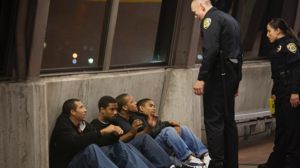First of all, hats off. Since collecting top honours at Sundance and Cannes, Fruitvale Station is undoubtedly on its way to wowing audiences and collecting prizes all over the world. And my most sincere congratulations to you specifically, Nina, for wading through what must have been some very tricky days at the casting office. I imagine your original casting call may have looked something like this: "Searching for Oakland area youths, male and female, early to mid-twenties, any race (though black applicants likely to be racially profiled and manhandled by police.) Based on true story…"
Writer-Director Ryan Coogler's first feature film is a dramatic recreation of the true story of 22-year old Oscar Grant's fatal shooting by a police officer in the early hours of New Year's Day, 2009. The incident took place at the Fruitvale Station on the Bay Area Rapid Transit Line in Oakland, California. There were many witnesses to the shooting, and it was even caught on video. Was your job easier, Nina, as a result of the wealth of resources that you could draw from?
Here's where your job wasn't necessarily made any easier: a mere three and half years later, Coogler is filming on the very same ground as where the fatal shooting took place, and this in the heated aftermath of the case of Trayvon Martin's fatal shooting at the hands of George Zimmerman… Talk about close to the bone in both time and place, it gives Apocalypse Now a run for it's money. There, Coppola's every effort to re-create accurately the atmosphere, character, and action of the Vietnam War undoubtedly stirred up some disquieting sensations locally.
But getting back to Oakland in 2012, it's precisely this physical, emotional, and topical proximity that gives the film such weight: by dancing between fact and dramatic re-enactment, in close time and place to the original incident, and with matters as sensitive as race relations, abuse of power, and the carriage of justice. It all makes for a tense and gripping experience. You were in charge of liaising with local talent, and populating the scenes. Coogler's desire to set his scene where it all went down must have made for some pretty sensitive briefing and conversations.
I'm thinking about where you were likely to have spent a good deal of time: the wonderfully poignant scenes of the train trips to and from the city. These are the moments that the film builds to. Here Oscar and his friends cram into a packed carriage and happily ride alongside gay, straight, black, Hispanic, and white passengers. They chat, joke, dance, and generally revel in life's possibilities. It's an ideal moment of peace through understanding. Later, on the ride back from the city, Oscar unfortunately snags on an unsettled score, and the situation steers toward the brutal place we already know it's going -- whether we like it or not.
The actors playing the passengers were all alive when Oscar Grant was shot. Some of them surely take that same route through Fruitvale Station, and all of them know that on any other day, when the cameras and lights aren't around, the same thing could happen again. Maybe this is why the film doesn't start with the actors you cast, but instead with the actual cell phone footage of Oscar Grant's shooting. It reminds us that the world we're about to enter is nobody's fantasy, that since Oscar Grant, Trayvon Martin was shot in the Florida suburbs, and that it will likely happen again unless we as a society stop being so quick to create villains out of stereotypes.







